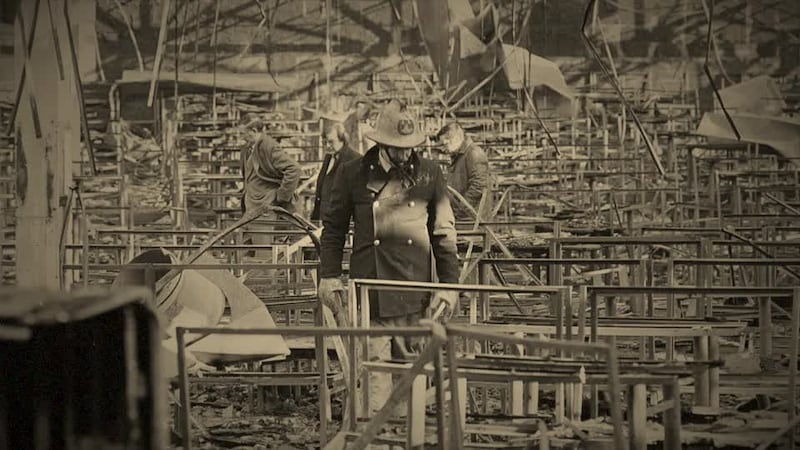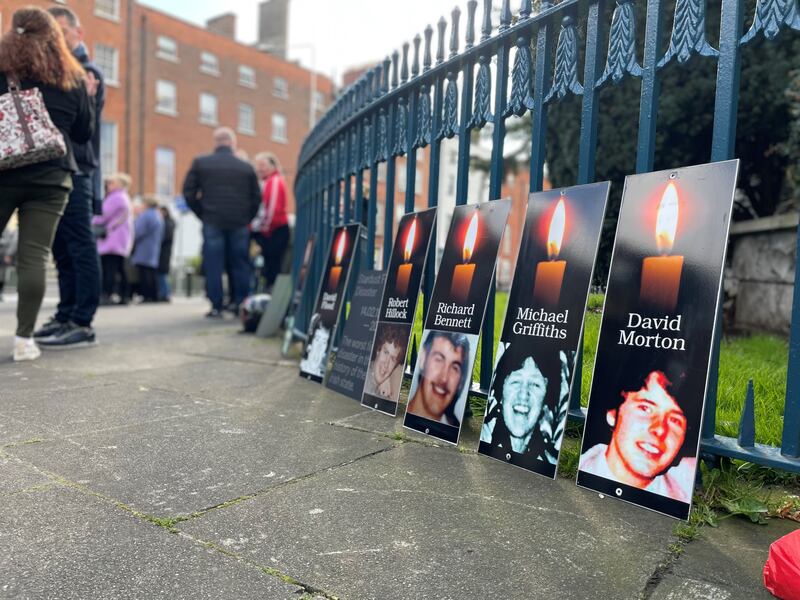On Thursday, in the Pillar Room on the campus of the Rotunda hospital in Dublin, the last of 48 “pen portraits” – short, descriptive biographies – of young people who died in a nightclub fire more than four decades ago were read into a court record.
The portraits, which have elicited laughter, smiles and many tears over the past four weeks, will probably be among the most memorable testimonies to be heard at the inquests into the deaths of 48 people, some of whom were children, at the Stardust nightclub in Artane in the early hours of February 14th, 1981.
Fresh inquests, ordered by former attorney general Séamus Woulfe in September 2019, will begin hearing evidence next month and are expected to last six months.
Read by family members or friends of the deceased, these are the first such portraits to be presented in this jurisdiction.
They were first used in the 2016 Hillsborough inquests, which inquired into the deaths of 97 people in a crush at a football match at Hillsborough Stadium, in Sheffield, South Yorkshire in April 1989. They were used at the 2018 inquests into the killing of 10 people in August 1971 during a British army operation in Ballymurphy, Belfast. The aim is to bring the lives of the deceased to the heart of proceedings, particularly where causes of deaths are contested.
Under the sensitive direction of Dublin coroner Dr Myra Cullinane, they have been delivered before a jury of seven women and eight men, and have been profoundly affecting. Families have spoken vividly of young people who lived and played and brought huge happiness to those who loved them, in a Dublin now long gone.
Most believe they were so treated because ... their children’s lives did not matter in the eyes of successive governments
Recalling an Ireland where family planning contraception was yet to be legalised, the portraits brought us into large, busy families. Most had at least four children. Some had 10 or more. We heard Caroline Carey (17), from Coolock, was one of seven children; Robert Kelly (17), from Coolock, was one of nine; Thelma Frazer (20), from Sandymount, one of 11.
As was common then, particularly in working-class families, most had left school by 16 – having completed their Inter Cert (forerunner to the Junior Certificate) – to work in paid employment, “handing up” most of their wages, earned in some cases in workplaces no longer in existence, to the household.
Jacqueline Croker (19), from Kilmore West, worked in Roches Stores, having been working since she was 15. Her sister Alison said: “Times were very hard financially for working-class families and Jackie’s help was of immense importance to our family.” Josephine Glen (16) from Coolock, had worked from the age of 14 “to help my mam, who was a single mother of four children,” said her sister Sheena. Brian Hobbs (21), from Whitehall, had just found employment in Sach’s hotel in Donnybrook. Kelly worked on the B&I ferries.
Many lived in homes without phones. They spent time in long-closed places like the Dandelion Market in St Stephen’s Green, Clerys department store and the SFX Hall in Sherard Street.
The centrality of music to their lives – the excitement it brought, its place in their identities and social lives – is detailed in almost every portrait. Referenced repeatedly was the weekly Top of the Pops Top-40 countdown. Favourite bands included Boney M., The Specials, The Clash, Bay City Rollers, Sham 69, Blondie, and The Undertones.
Out of his first wage packet, Richard Bennet (17), from Coolock, “bought himself a Walkman and liked listening to tapes like Donna Summer, Status Quo and Led Zeppelin. He used to record his favourite songs off the radio so he could listen back to them”, Christy Moore told us, reading a portrait penned by Richard’s mother Helen, who was ill.

Of the 48 who perished, four were 16 years old and 10 were 17; 21 were aged between 18 and 20, with 13 aged between 21 and 27.
More than half – 35 – left homes that night of February 13th, 1981, in areas around Coolock village – Donnycarney, Edenmore, Kilmore West, Artane, Raheny, Kilbarrack. Five were from neighbouring Finglas, Whitehall and Beaumont, with others from Swords, Ringsend, Sandymount and the north inner-city in Dublin. Also Co Meath, Derry and Belfast.
From the 1960s, the then Dublin Corporation – now Dublin City Council – built thousands of houses in the north Dublin area, rehoming families from over-crowded, tenement-like conditions in the inner-city and elsewhere.
Among those that moved were the Keegans, who lost Mary (19) and Martina (16). Lorraine Keegan, in her portrait of Martina, told how their late parents, Christine and John, and their three children had been living with extended family in Ballyfermot in 1964 when Martina was born.
They told staff in the Coombe hospital about their housing conditions. “To our parents’ surprise, an inspector immediately called to our auntie’s house to do the inspection and in the following couple of days, our parents got our new three-bedroom family house in Coolock. Our parents were delighted and excited to bring their newborn baby Martina home to a brand new house with lots of room for us all at last.”
Of the 90 parents who lost children to the fire, just 14 are still alive
And, despite a bleak economy through the 1970s and 80s, there were good employers around Coolock – Cadbury’s, Chivers, and Scotts Foods are referenced. The young people had jobs in Superquinn, RTV Rentals or other shops in the Northside Shopping Centre.
By 1981, these families’ children were among the first to come of age, to be old enough to go to nightclubs like the Stardust. They had “a few bob” in their pockets, friends and their “whole lives ahead of them”. The Stardust destroyed all that, casting an enduring pall over thousands of lives.
Alison Croker described the funeral of her sister Jacqueline (19), from Kilmore West. “There were four coffins laid out in the church. One was that of Julie McDonnell, who was my football coach. One was of Caroline Carey, who I knew from Irish dancing. One was Michael Griffiths, who I knew through Jackie, and one was our Jackie.”
She continued: “Everyone knew everyone in our community ... each loss was felt by the community as well as the families. Living at home after the Stardust fire, you wouldn’t be able to get on to a bus without seeing someone either with visible scarring ... or someone known to you who had lost someone in the fire.
“Nobody ever spoke about it with each other in the community because you would have no idea how the other person would react to something so emotional and affecting. It felt like everybody was left on their own.”
The 48 grew up in 45 families. Of the 90 parents who lost children to the fire, just 14 are still alive. Descriptions of the impact on parents have been ineffably sad.
Susan Meehan’s late father never recovered from the loss of her brother, John Colgan (21) from Swords. “I have horrible memories of finding him on all fours in the bathroom, crying and pleading for help to see a way forward. He did manage to move forward with the strength and support of my mother.”

Maurice Frazer, whose sister Thelma (20) from Sandymount died, said of his late parents: “Our mam was heavily sedated ... our dad went missing for a few hours ... He was brought back to the house by a passing garda who found dad sitting on a bench on Sandymount Strand crying his eyes out.”
Brigid McDermott (86), who lost three children, aged 22, 18 and 16, spoke briefly after three of her daughters read portraits. Linking arms with her granddaughter and leaning on a walking stick, she told the inquest: “I am the mother of William McDermott, Marcella and George who I loved very much”. In a frail voice she said: “They went out that night, and they never came home to me. And I miss them. And I love them. God bless them.”
Anger at how the families were treated by the authorities in 1981, and since, ran through the portraits. Many families were refused the opportunity to see their dead – told the coffin was closed and “to remember them the way they were”, told which undertakers would handle the funerals, told when the funerals would be, told which graveyard they would be buried in.
They had to battle for paltry compensation and had to sign non-disclosure forms. They describe being “fobbed off” through the decades. The “not knowing” – why the fire started, why it engulfed the venue so catastrophically, why their loved ones died – exacerbated and prolonged their trauma. Numerous portraits spoke of “heartbreak” at parents and siblings dying without being afforded the dignity and respect of answers.
Most believe they were so treated because so many of them were working-class, northside Dublin families; that their children’s lives did not matter in the eyes of successive governments.
Delivering the portraits has been difficult and emotional. Families have travelled from across Dublin, and also from Belfast, Derry, Meath, Wales and London to give their loved ones’ lives expression at the Stardust fire inquests.
Maria Farren, who read the portrait of her sister Paula Byrne (19), from Coolock, in the opening days, said her family hoped “justice will now prevail” and the truth behind events that caused “such devastation, pain and agony to our family and so many others” would finally be delivered to them.
“For all parties involved in this inquest we wish you Godspeed on your journey with the responsibility that is entrusted to you,” she said.










